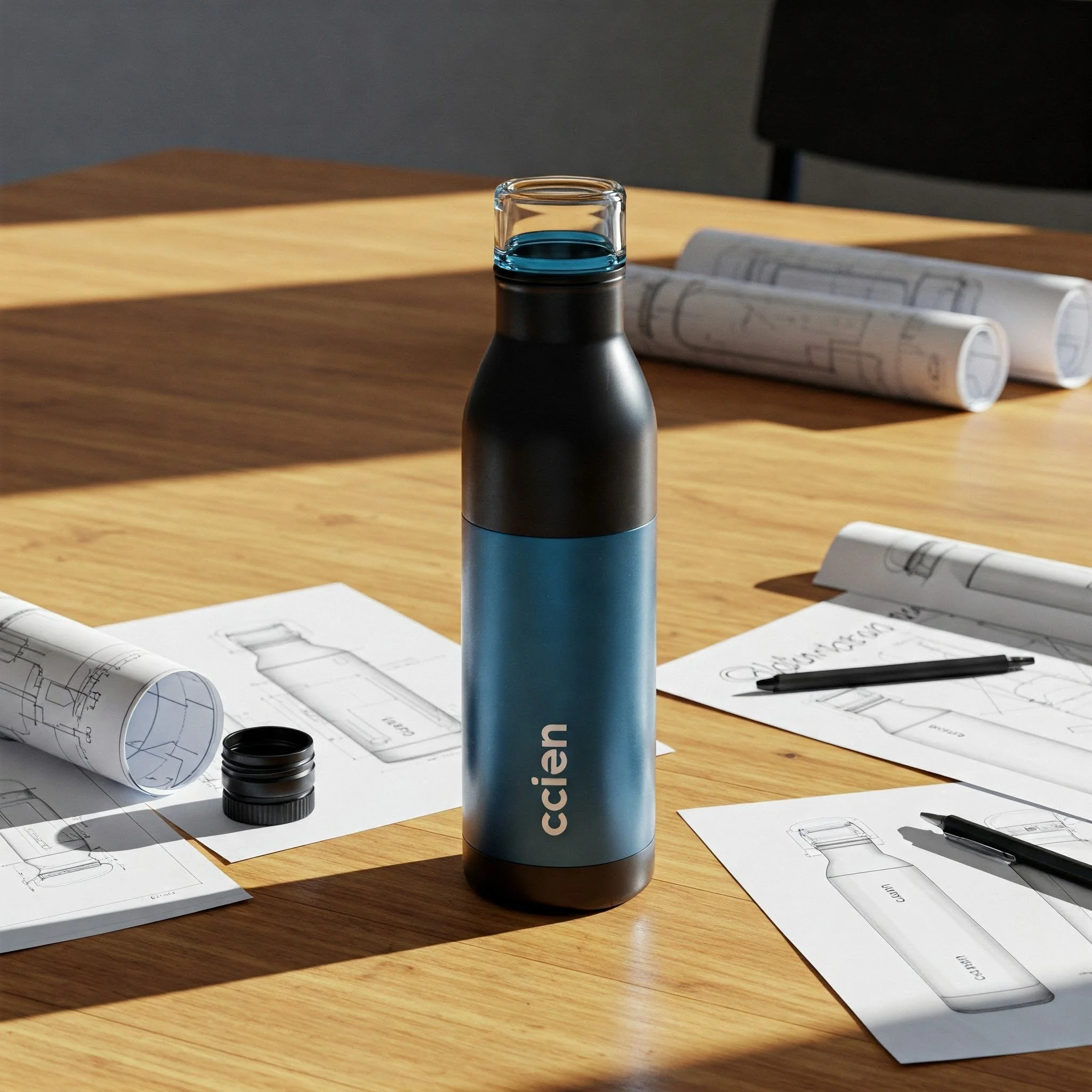The Hidden Cost of "Free": Devaluing Design in the Manufacturing Landscape
You can have a great idea in mind, but without the right partner, that idea may not flourish.
Why separating design and manufacturing services can lead to better products and stronger businesses.
John, a passionate entrepreneur with a growing hiking and outdoor brand, was ready to launch his next big product: a revolutionary new water bottle designed for extreme conditions.
He envisioned a sleek, durable, and user-friendly design that would stand out in a crowded market.
Naturally, he started reaching out to manufacturers, hoping to find a partner to bring his vision to life.
He was quickly presented with an enticing offer: several factories promised to handle not only the manufacturing but also the product development, absorbing a significant portion, or even all, of the research and development costs.
"Free design" – what could be better? Like many business owners, John was initially drawn to the apparent cost savings. But he soon discovered that "free" often comes with a hidden, and much higher, price.
The Allure of "Free Design": Understanding the Manufacturing Perspective
The offer of "free design" is a common tactic in the manufacturing world, particularly when dealing with overseas factories.
For manufacturers, it serves multiple purposes.
First, it's a powerful competitive advantage, a way to attract clients who are understandably focused on minimizing upfront expenses.
Second, it can create a form of client lock-in. Once a manufacturer has invested time and resources in developing a design, even if it's "free," the client is less likely to switch to a competitor.
Third, some manufacturers believe that integrating design streamlines their internal processes, allowing them to move quickly from concept to production.
Their core business, after all, is making things, and design is often viewed as a necessary step, but not necessarily a core competency.
This often centers the manufacturer's focus on the production of a product. And while extremely important, it is only one of the many stages involved in The Hidden Costs of "Free Design": Risks for Businesses like John's.
John, initially thrilled with the prospect of saving on design costs, quickly encountered the downsides of this approach.
The first factory presented a design that, while functional, felt generic and lacked the unique aesthetic he envisioned for his brand. It looked like any other water bottle on the market, failing to capture the rugged, innovative spirit of his company.
The second factory's design prioritized ease of manufacturing over user experience, resulting in a bottle that was awkward to hold and prone to leaking.
John's "free design" was quickly becoming a costly mistake. He realized he was experiencing firsthand the common pitfalls:
Compromised Quality: The designs were rushed, lacking the depth of research and refinement that a dedicated design process would provide.
Lack of User Focus: The manufacturers prioritized their production capabilities over John's target audience's needs and preferences. The bottle, while technically sound, wasn't inspiring.
Missed Innovation: There was little exploration of alternative design concepts or innovative features that could truly differentiate John's product.
Weak Brand Identity: The generic designs failed to reflect the unique personality and values of John's outdoor brand.
Communication Breakdowns: John struggled to communicate his vision to the manufacturers' design teams, leading to misinterpretations and frustration.
You will never own the design: Even if the supplier is telling and promising you “we will only sell this design to you”, this may not necessarily be true. Chances are you will quickly see dupes or almost identical products rolling out in every competitor store. And there is not much you can do about this.
John was starting to see that the money he saved upfront was likely to be dwarfed by the potential losses from a poorly designed product that failed to resonate with his customers.
The Impact on the Design Profession: Devaluing Expertise
The "free design" trend isn't just harmful to businesses like John's; it also has a detrimental impact on the design profession as a whole.
By treating design as a throw-in service, manufacturers devalue the expertise, creativity, and strategic thinking that professional designers bring to the table.
This creates a race to the bottom, where designers are pressured to lower their rates or offer their services for free in order to compete.
The fun thing is that every business wants to have products like Apple, Samsung, Tesla and others, but then they want to pay the Shein price.
It fosters a perception that design is a simple, easily replicated commodity, rather than a complex and valuable discipline.
And sadly, sometimes design can be commoditized, generallized and simplified to a point where it loses all value. But is that what you want for your product and brand?
This can discourage talented individuals from pursuing design careers, leading to a decline in innovation and overall product quality.
The Alternative: Recognizing Design as a Strategic Investment
Fortunately, John learned from his early experiences. He realized that viewing design as a mere expense was shortsighted. Instead, he started to see it as a strategic investment – a crucial component of his product's success. He decided to seek out an independent design studio, one that specialized in outdoor products, and understood his brand's vision. This shift in perspective marked a turning point for his product development journey.
The Benefits of Independent Design Partners
By partnering with an independent design team, John gained access to:
Objective Perspective: The designers offered a fresh perspective, unconstrained by the manufacturing limitations that had influenced the factories' designs.
Specialized Expertise: The studio had a deep understanding of ergonomics, materials, and user experience in the outdoor gear market.
User-Centric Approach: They conducted thorough user research to understand the needs and preferences of John's target audience, informing every design decision.
Stronger Brand Focus: The designers worked closely with John to develop a design language that truly reflected his brand's identity and values.
Greater Flexibility and Control: John had direct communication with the design team and full control over the design direction.
The ownership of the design is yours: By having a dedicated design team that assists you on research and developing the product, since its inception the ownership of the design is transferred to you, the business owner. Which gives you the freedom to go to one or multiple manufacturers with no issues.
How to Find the Right Design Partner
John's success hinged on finding the right design partner. He learned to prioritize:
Expertise in his niche: He sought out designers with a proven track record in the outdoor industry.
Clear Communication: He valued open dialogue and a collaborative approach.
User-Focused Methodology: He looked for a design team that emphasized user research and testing.
A Portfolio that Resonated: He reviewed their previous work to ensure their style aligned with his vision.
At Box Creative, we believe that close collaboration and a deep understanding of the user's needs are crucial for developing successful products. We see ourselves as partners in our clients' success, not just service providers.
Case Studies
Let's consider a hypothetical example: A company launching a new line of pocket knives initially opted for "free design" from their overseas manufacturer. The resulting knives, while technically functional and meeting basic safety standards, lacked the refined ergonomics, premium materials, and distinctive aesthetic that would attract discerning customers in a competitive market. Sales were sluggish, and customer feedback highlighted issues with grip comfort and blade deployment. After recognizing the limitations of this approach, the company partnered with an independent design firm specializing in outdoor gear and everyday carry (EDC) products.
The design firm conducted thorough user research, interviewing avid outdoorsmen, knife collectors, and everyday users to understand their needs, preferences, and pain points. They explored various handle materials, blade shapes, and locking mechanisms, creating multiple prototypes for testing and refinement. The redesigned pocket knife featured:
Ergonomic Handle: A contoured handle made from G-10, a durable and textured composite material, providing a secure and comfortable grip even in wet or cold conditions. The texture was strategically placed to maximize grip without being overly aggressive.
Improved Blade Deployment: A smoother, more reliable opening mechanism that could be easily operated with one hand, addressing a key complaint about the original design.
Premium Blade Steel: An upgrade to a higher-quality steel that offered better edge retention and corrosion resistance, enhancing the knife's perceived value and longevity.
Distinctive Aesthetic: A design language that reflected the brand's commitment to quality, durability, and understated elegance, setting it apart from generic-looking competitors.
The result? The redesigned pocket knife saw a significant increase in sales, garnering positive reviews and establishing the company as a serious contender in the EDC market. This highlights the tangible return on investment that quality, user-centered design can deliver, even for a seemingly simple product like a pocket knife. Another example might be a local Startup who refines an existing product through the use of clever design.
Conclusion
The "free design" model might seem tempting on the surface, but it often comes with hidden costs that far outweigh any initial savings. Design is not a commodity; it's a strategic asset that can make or break a product's success. For businesses like John's, investing in quality design is an investment in their brand, their customers, and their long-term profitability. For designers, it's a call to champion the value of their expertise and resist the pressure to devalue their work. By recognizing the true power of design and fostering strong partnerships between businesses and designers, we can create products that are not only functional and beautiful but also truly meaningful and impactful.
What are your thoughts on the value of design in product development? Have you experienced the benefits of investing in independent design expertise, or have you encountered the pitfalls of the "free design" approach? Share your experiences and insights in the comments below! Let's start a conversation about how we can elevate the role of design in the manufacturing landscape.


